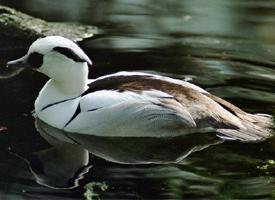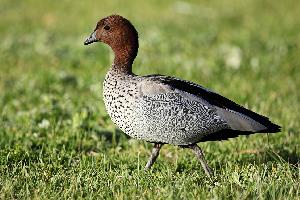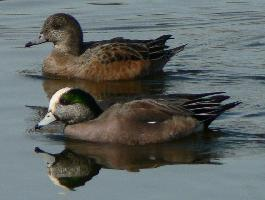
Statut de conservation
| Menacé |
Description de l'animal
The Smew (Mergellus albellus) is a captivating species of duck that belongs to the Anatidae family, enchanting bird enthusiasts and ornithologists alike with its distinctive appearance and unique behaviors. This small diving duck is the sole member of the genus Mergellus, setting it apart from its relatives with its specialized characteristics and lifestyle.Adult male Smews present a striking plumage that is hard to miss. They are predominantly white, adorned with black markings that create a crisp, clean appearance. Their black back is intricately patterned with white lines, resembling fine lacework, while their head is characterized by a large, black patch around the eye that extends towards the back of the head, creating a distinctive 'cracked ice' or 'panda' effect. This, coupled with their red-brown eyes and a slender, hooked bill, gives the males an unmistakable and elegant look.
Females and juvenile Smews are more subdued in coloration, featuring a grey body with a rust-colored head and a white cheek patch, which provides a beautiful contrast and makes them easily distinguishable from other ducks. Their eyes, too, are red-brown, mirroring the intense gaze of the males, though they lack the dramatic black and white plumage.
Smews are relatively small ducks, with a body length ranging from 38 to 44 centimeters (15 to 17 inches), and a wingspan that spans approximately 60 to 67 centimeters (24 to 26 inches). Their size and sleek body shape facilitate their lifestyle as expert divers, plunging into cold, clear waters in search of food. Their diet primarily consists of small fish, aquatic invertebrates, and occasionally, aquatic plants, showcasing their adaptability and skill in hunting underwater.
Breeding primarily in the taiga forests of the Northern Palearctic, across Scandinavia, Russia, and Siberia, Smews favor secluded areas near freshwater lakes, slow-flowing rivers, or sheltered coastal inlets. They nest in tree cavities, often those left by woodpeckers, or in nest boxes provided by conservationists. This preference for specific nesting sites makes the preservation of their habitat crucial for their survival.
During the winter months, Smews migrate to more temperate regions, with many heading to sheltered coastal waters, estuaries, and inland lakes of Europe and eastern Asia. This migration is essential for their survival, as it allows them to access open waters and abundant food sources even in the coldest months.
Smews are social birds outside of the breeding season, often forming small flocks. However, they are also known for their elusive nature, preferring to keep a distance from human activity. Their calls, though not often heard, are described as soft and whistle-like, adding an auditory allure to their already captivating presence.
Conservation efforts for the Smew focus on preserving their natural habitats and nesting sites. While they are not currently classified as endangered, their populations are affected by habitat loss, pollution, and climate change, making conservation work essential for their continued survival.
In summary, the Smew is a remarkable and elegant bird, whose unique appearance, fascinating behaviors, and specialized habitat preferences make it a cherished species among birdwatchers and conservationists. Its presence enriches the biodiversity of the regions it inhabits, underscoring the importance of efforts to protect these beautiful creatures and their environments.
Animaux similaires
Nouvelles photos d'animaux
Top 10 des animaux
- Dolphin gull (Leucophaeus scoresbii)
- Diana monkey (Cercopithecus diana)
- Moustached guenon (Cercopithecus cephus)
- Galápagos tortoise (Geochelone nigra complex)
- Russian tortoise (Testudo horsfieldii)
- Japanese macaque (Macaca fuscata)
- Stone loach (Barbatula barbatula)
- Greek tortoise (Testudo graeca)
- Common flying dragon (Draco volans)
- Colossal squid (Mesonychoteuthis hamiltoni)


